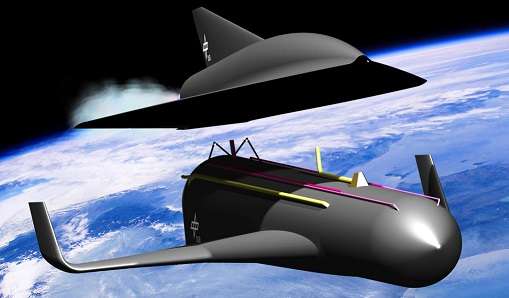SpaceLiner: Europe-Australia, 90 minutes, Europe-US, one hour (original) (raw)

In aviation circles, the talk of the future involves phrases like "space planes" and "hypersonic atmospheric flight vehicles." A group presently in the spotlight is from Germany; they are carrying a roadmap for low-cost space access which involves calling upon the air passenger market for fast-travel flights.
Welcome to the world of SpaceLiner, which, when fully developed, could have dramatic impact in global aerospace. The DLR Institute of Space Systems said this suborbital, hypersonic, winged passenger transport idea is under investigation at DLR-SART. (DLR is a German aerospace research agency and it evaluates complex systems of space flight. SART is Space Launcher Systems Analysis.)
SpaceLiner is a rocket-propelled intercontinental passenger transport, described by the institute as a two-stage vehicle powered by rocket propulsion.
Guy Norris, Los Angeles-based senior editor for Aviation Week, described it as a rocket-powered system that incorporates a flyback booster and other dual-use technologies which could also be applied to "architectures for launching payloads into low Earth orbit." Conceived as a winged airliner carrying 50 passengers from Europe to Australia in 90 minutes, Norris added that, to serve a potentially larger market, DLR has also outlined a 100-seat version that would be capable of one-hour intercontinental and transpacific missions.
The concept being laid out in detail sounds like a business feasibility study as much as a technical initiative. The backdrop for all this lies in the cost factor in space transportation. This has been a key challenge. Production is one of the main cost drivers due to the very low manufacturing numbers of stages and engines. If the number of launches per year were to be increased, manufacturing and operating cost of launcher hardware would shrink. Without a new market application for space technology no improvement is to be expected, said the Institute. What could ignite a larger market?
"A new kind of high-speed transport based on a two-stage Reusable Launch Vehicle (RLV) has been proposed by DLR under the name SpaceLiner," they stated.
Liquid hydrogen and liquid oxygen will be used as propellants. They said the combination was both powerful and eco-friendly."
The reusable vehicle would be accelerated by 11 liquid rocket engines—nine for the booster and two for the passenger stage, operated using the cryogenic liquid oxygen and hydrogen.
Mark Prigg in the Daily Mail said that "Engineers predict that advances in materials could be combined with new cooling technologies and heat shielding to safeguard the SpaceLiner's structures against the intense heat of hypersonic flight."
The passenger cabin could function as an autonomous rescue capsule that could separate from the vehicle in case of an emergency, allowing the passengers to return safely to Earth.
The SpaceLiner could play a cost-cutting role by stimulating large production runs of reusable rocket engines and booster vehicles.
Martin Sippel, leader of the SpaceLiner project at DLR's Space Launcher Systems Analysis group, talked to Aviation Week about these plans.
"We could increase hundredfold the number of launches and, as it is a reusable vehicle designed for between 150 and 300 flights, you have serial production of engines. If you have 11 engines per vehicle then you would build 2,000 engines per year or so. That's a huge production run, and that was the motivation."
The concept involves a two-stage, vertical-takeoff configuration of a large unmanned booster and a manned stage designed for 50 passengers, for example, and two crew members. The fully-reusable vehicle is accelerated by a total of eleven liquid rocket engines (9 for the booster, 2 for the passenger stage), which are to be operated using cryogenic liquid oxygen (LOX) and hydrogen (LH2).
After engine cut-off, the orbiter stage is to enter a high-speed gliding flight phase and be capable of traveling long intercontinental distances within a very short time. Altitudes of 80 kilometers and Mach numbers beyond 20 are projected, depending on the mission.
Long-distance trips such as Europe –Australia could be accomplished in 90 minutes. An intercontinental route between Europe and North-West America could be reduced to flight times of slightly more than one hour.
We are talking about a new era, potentially, of rocket-based, ultra-fast transportation as a new application for launch vehicles.
The group mentioned other intercontinental missions, which potentially could generate market demand.
With SpaceLiner travel, the thinking is that production rates of the reusable launch vehicles and rocket engines could increase hundredfold.
What's next on their roadmap? Norris said that early concept reviews would take place around 2016-17; the next review, in 2019-20. After that, Norris described various next steps before building the first hardware in 2030. Flight tests of the prototype could begin in 2035, with service entry in the 2040s. "It sounds a long way off into the future but we need to achieve our 2020 goal of funding, otherwise we cannot keep these later dates," Sippel said in Aviation Week.
© 2015 Tech Xplore
Citation: SpaceLiner: Europe-Australia, 90 minutes, Europe-US, one hour (2015, August 20) retrieved 19 November 2024 from https://techxplore.com/news/2015-08-spaceliner-europe-australia-minutes-europe-us-hour.html
This document is subject to copyright. Apart from any fair dealing for the purpose of private study or research, no part may be reproduced without the written permission. The content is provided for information purposes only.